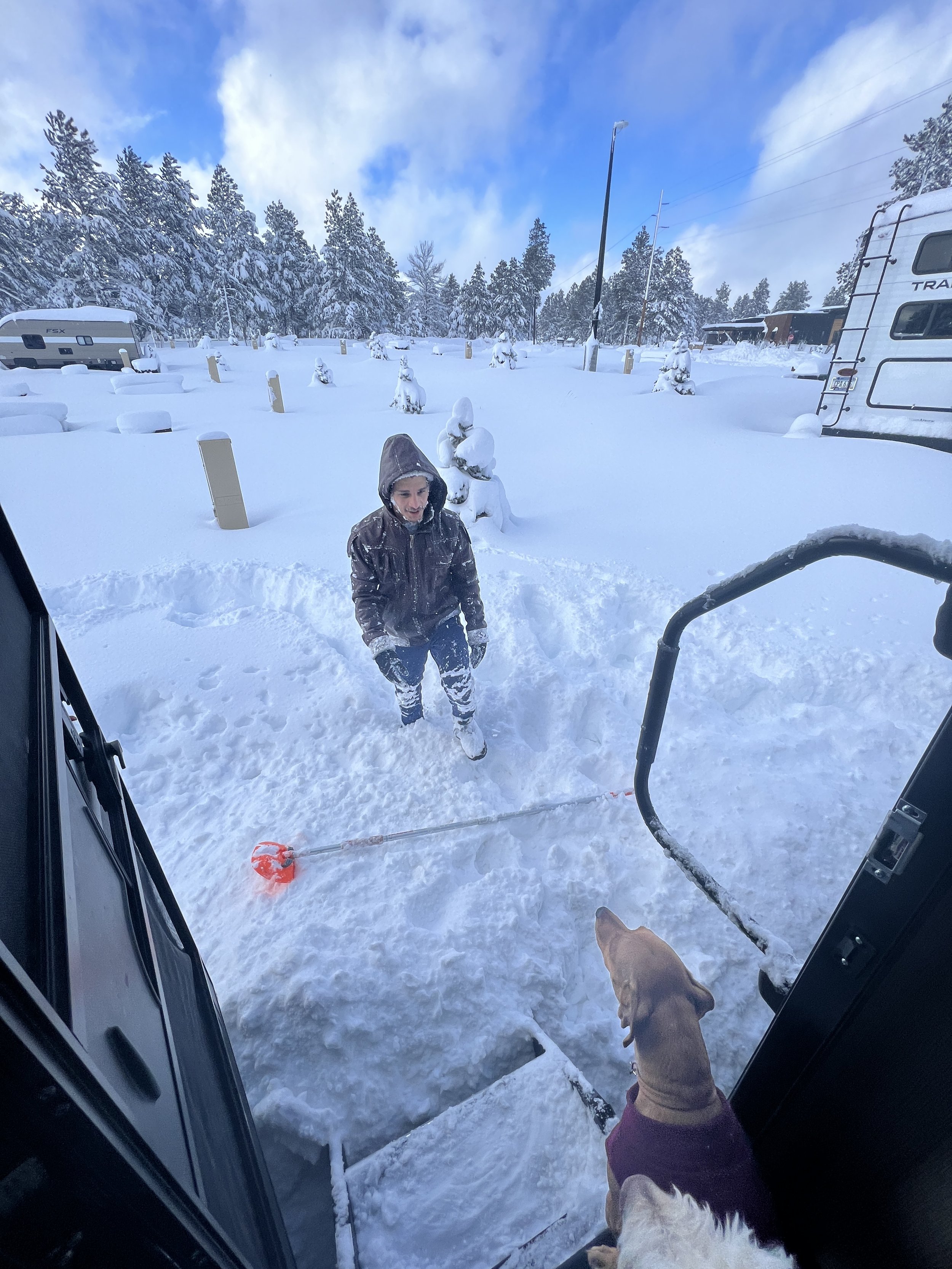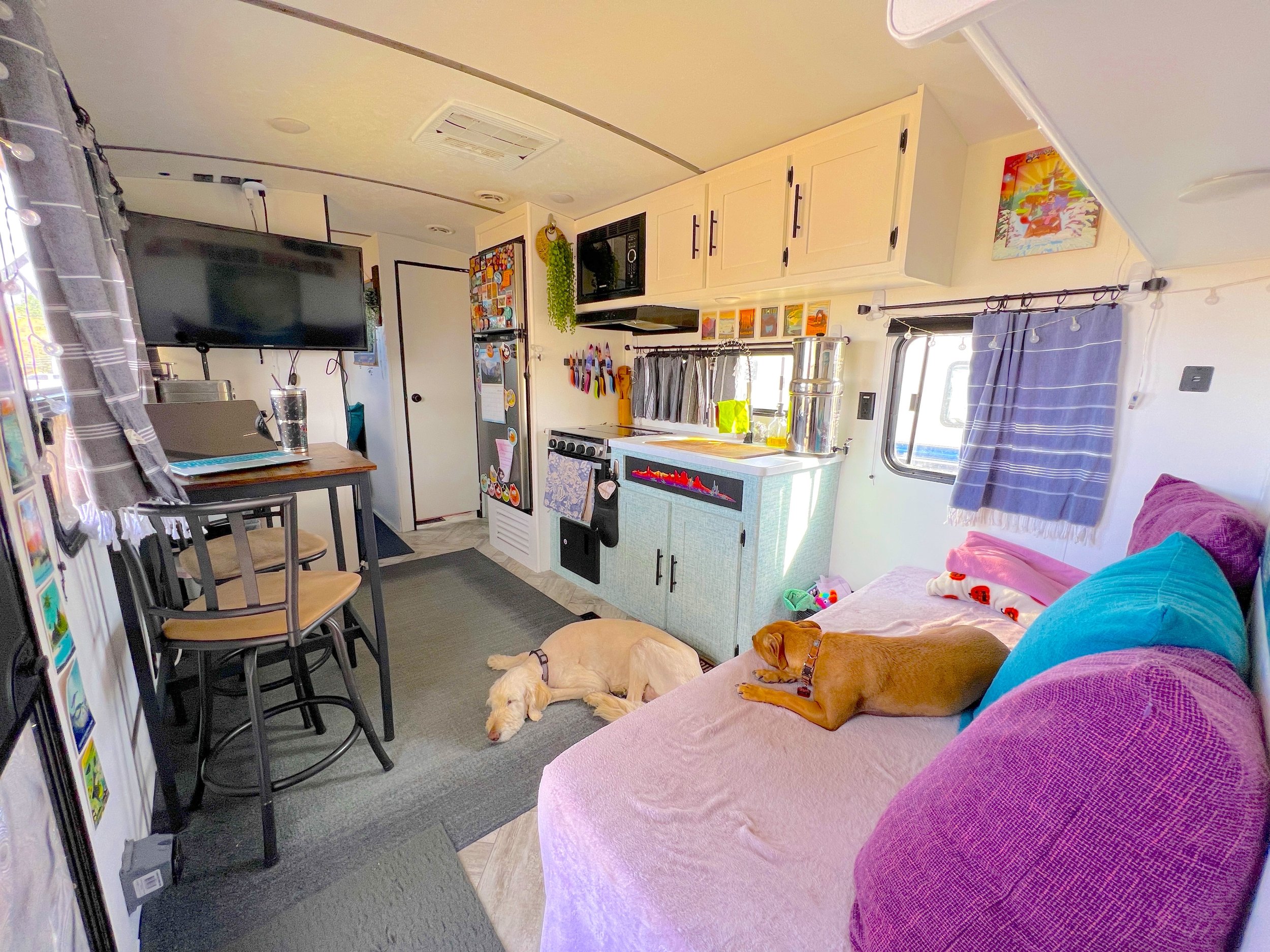Preparing for an RV trip this winter? Check out our 11 tips for camping in cold & snowy weather.
This past winter we spend 2 long months at Village Camp Resorts in Flagstaff Arizona where we received a record breaking 90 inches of snow.
If you’re thinking Arizona? Snow? Yes, Arizona gets snow and lots of it apparently!

As two Florida natives we had no absolutely experience for handling snow in a house let alone in an RV. And while seeing the magic of winter in places like Zion National Park or Breckinridge Colorado is something to mark off your bucket list, it doesn’t come without its challenges. Winter camping requires a bit more attention than regular camping, specifically to your water and heat sources.
Once you’ve got those covered you can sit back, relax, and enjoy your hot cocoa.
This post contains affiliate links, so we may earn a small commission when you make a purchase through links on our site at no additional cost to you.

TIP #1. KEEP YOUR WATER FLOWING
Keeping your water lines from freezing is one of the most important tasks when camping in the winter. Frozen lines not only restrict your access to water but it can cause damage to your pipes and varies other parts of your RV.
There are a few options when managing water in the winter.
#1. Heated Hose: A heated hose is a hose that has been wrapped with a heat cable and plugs into the pedestal at your site, keeping the hose warm. These come ready to be connected and require no additional handling.
Pros: Convenient.
Cons: Expensive & bulky.

Camco 25-Ft Heated Water Hose for RV – Water Line Freeze Protection Down to -40°F/C – Features Energy-Saving Thermostat & Includes Adapter for Connection to Either End of Hose (22923)
#2. DIY Heated Hose: A DIY heated hose takes a regular RV Drinking Water Hose and wraps it in a Heating Cable then tucks it in Insulating Foam Pipe Covers. These are essentially the same as the heated hoses on the market but less expensive because you are putting it together yourself.
Pros: Inexpensive.
Cons: Requires you to do it yourself.

Insulating Foam Pipe Covers Pipe Insulation Freeze Protection Heat Preservation Foam Tube for Tubing Outdoor Water Pipe Insulation Water Pipe Freeze Protection (24 Pcs,Black,1 Inch)

HEATIT Pipe Heating Cable – Reliable Freeze Prevention, Easy DIY Install, Durable Design for Water Pipes CSA & ETL Certified, Energy-Efficient Water Pipe Heat Cable HISD 9ft, 7w/ft, 120V
#3. Fill your fresh water tank: If you don’t want to deal with managing water hoses and heat cables then you can fill up your fresh water tank and use the water pump in your RV. This is a great option if you are experiencing brief cold temperatures and don’t want or need to deal with heated hoses.
Pros: Don’t have to deal with your hose freezing.
Cons: Requires you to fill your tank and monitor your water usage so you don’t run out.
#4. Leave a drip: This is another great option for brief trips in the cold or as an additional precaution when using a heated or regular hose. To leave a drip all you do is keep just a small stream of water running, preferably in the sink. This keeps the water flowing when temps get below freezing.
Pros: Water won’t freeze.
Cons: Requires you to remember to keep the drip going especially in the night if you use the sink.

TIP #2. USE A SPACE HEATER
Most RVs come with a furnace built in which is essential when camping in cold or snowy weather. However it can suck up a lot of propane if you are relying on it alone to heat your space. When camping at a site that has electricity it’s helpful to utilize a space heater to continuously keep your RV warm. Make sure to never leave your space heater on or plugged in when you’re not inside.
While camping in Flagstaff Arizona this winter we used space heaters during the day and added the furnace at night when the temperatures really dropped.
TIP | If the temperature drops below 32 degrees you’ll want to have the furnace going to keep the water lines under the RV from freezing.

Dreo Space Heater, 25″ 11.5ft/s Fast Heating Portable Electric Heater with Remote and Anti-Burn Plug, 5 Modes, Overheating & Tip-Over Protection, Oscillating Ceramic Heater for Indoor Use, Gold

TIP #3. PUT A HEATED BLANKET IN YOUR BED
For a warm and cozy bed, lay a heated blanket under your comforter and turn it on about 20 minutes before you plan to go to bed. This warms up your sheets and makes your bed super cozy. It’s also nice to be able to turn on in the middle of the night if you get cold.
This is a true game changer when camping in winter. There’s nothing worse then getting into a cold bed when it’s cold outside.

Heated Electric Blanket Full Size 72″ x 84″ Soft Warm Flannel with 4 Fast Heating Levels & 10 Hours Timer Auto Shutt Off, Heating Warm Blanket for Full Body – Dark Gray

TIP #4. INSULATE YOUR WINDOWS
Windows on an RV are a big access point to the temperatures outside. And while there are a variety of RV windows available on the market from tinted to dual pane, keeping them covered with either Reflectix Double Pack Insulation or RecPro Blackout Roller Shades is a big help in keeping the cold out and the warm in.

RecPro RV Blackout Roller Shades | Darkening Window Cover for RV and Camper Blinds | Cordless | Woven Black (32″ W x 32″ H)
Reflectix is a 5/16-Inch thick, seven layer, reflective foil that comes in roll of varies sizes. To use you’ll measure the window you’ll be insulating and cut out a piece of reflectix adding about one inch or two to your window measurements. Place it in your window, cover with a curtain, and you’re good to go.

Reflectix BP24010 Series Foil Insulation, 24 in. x 10 ft, Multicolor

TIP #5. GET A SKIRT
If you are going to be staying put for the winter in a location that receives a large amount of snow you might consider getting a skirt for your RV made by EZ Snap.
EZ Snaps RV Skirting Kit is a do it yourself project that is made of diamond weave fabric that attaches all around the bottom of your RV, creating a seal of protection from the snow and cold. No drills or special tools required.

EZ-SNAP RV Skirting Kit for 31-35 Feet Long, 60″ Tall Travel Trailer with 2 or More Slide Outs with Combo Studs No-Drill Snap Fasteners in Black Quick & Easy to Install for Winter

TIP #6. KEEP A LIGHT BULB ON IN THE BAY
A 75 watt work light is an easy way to create just enough heat in areas you don’t want to freeze, such as, the bay where your water connections are. These come with a hook for hanging, metal guard for protection, and plug in to a standard wall outlet.
We kept a work light where our tankless heater is even though our water heater has a freeze protection on it. In order for most tankless water heater’s freeze protection to work water needs to be flowing through the lines, so, keeping that area from warm is a must.

[UL Listed] Cable Matters 25ft 75W Trouble Light with Cord, 16 AWG Old School Drop Light/Incandescent Work Light with Built-in Outlet and Metal Guard in Orange for Indoor and Outdoor Use

TIP #7. MONITOR THE TEMPERATURE
Temperature sensors are great to have to monitor the temperature in important areas, such as, the bay where your water connections are, as well as, where your tankless water heater is if you have one. You’ll want to make sure those areas stay above freezing or you could be without water.
Sensor Push Monitoring System allows you to monitor the temperature by placing a sensor in the area you want to monitor. Set your preferred temperature range and get alerted via a Bluetooth connection on your phone when temperatures are out of bounds.
Once your lines freeze it can take a lot of work to thaw them out so being able to monitor the temperature in important areas and be alerted when they get to low is extremely helpful in avoiding frozen pipes.

SensorPush HT1 Wireless Digital Thermometer/Hygrometer for iPhone/Android. USA Developed and Supported Humidity/Temperature/Dewpoint/VPD Monitor/Logger. Indoor/Outdoor Smart Sensor with Alerts

TIP #8. KEEP YOUR BLACK TANK CLOSED
Keeping the black tank closed is a general RV rule for allowing proper flushing. However when camping in the winter it is especially important. If your black tank is left open then you may find yourself with frozen waste, also known as a “poopsicle”.
To avoid this, simply keep your black tank closed until it’s full and you should avoid any unwanted messes.

TIP #9. GET A SHOVEL
A snow shovel is not a typical item that most people carry when RVing but if you’re winter camping in places that get a good amount of snow it’s an essential tool. It’s helpful in removing the snow from the roof of your RV & slides, your car, and around the door so you can get in and out easily.
It’s also important not to let a build up of snow stay on the roof or slides for too long because it will turn to ice making it hard to remove and cause possible damage to your roof & slides.

ErgieShovel ERG-SNSH18 Steel Shaft Impact Resistant Snow Shovel, 18-Inch Shovel, 48-Inch Shaft, Push/Scoop Combination Blade, Polycarbonate Shovel

#10. BRING EXTRA TOWELS
The snow, while beautiful, is pretty messy. Carrying a handful of extra towels to wipe your boots off, clean the dogs, and keep by the front door is essential in keeping your RV clean and not letting it become a muddy & slushy mess.

#11. GET A PAIR OF WATERPROOF SNOW PANTS
Waterproof Snow Pants are extremely helpful to have when you need to get outside and shovel snow. You will undoubtedly get wet when in the snow so having pants that will keep you from getting soaked makes dealing with the snow so much easier.
After receiving 36 inches of snow in 3 days Mike spent a good amount of time outside clearing the roof and a path for Griffin & Lucy to use the bathroom. Having these pants made it much more comfortable for him and probably helped him avoid a cold.

Jessie Kidden Mens Waterproof Hiking Pants, Outdoor Snow Ski Fishing Fleece Lined Insulated Soft Shell Winter Pants (6070 Black, 29)

We hope you found this post helpful! Let us know in the comments where you’ve winter camped!




